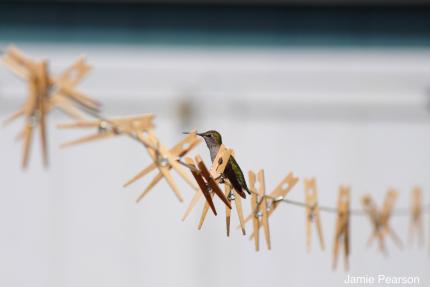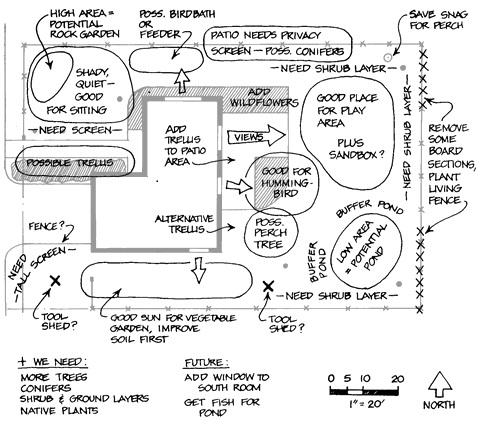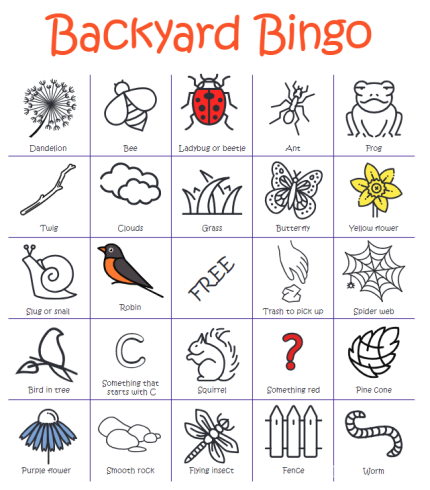
You don’t have to trek through the wilderness to enjoy wildlife. Whether you live in an urban, suburban, or rural setting, wildlife is as close as your own backyard! A typical neighborhood in Washington has more than 25 species of birds and mammals. Hawks, raccoons, and even foxes, frequent some Washington neighborhoods. Robins, squirrels, and chickadees are so familiar to us, we sometimes forget they are wildlife, too.
Materials
Habitat at home
While each backyard is unique, every backyard is a habitat. That makes each of us a habitat helper, and it is our responsibility to strengthen a healthy living community. When we plant trees, shrubs, and flowers around our homes, we are also building homes for a whole community of animals. Even if we plant only a few useful plants, we are improving the habitat for wildlife. Whether you spend a day, a week, or several years doing it, your backyard can become a better home for the wildlife already living there and a home for new wild neighbors.
An ideal backyard habitat should have food, water, shelter, and space. Watch the short video series below from the National Wildlife Federation to learn more.
Video 1: Backyard habitat
Video 2: Food
Video 3: Water
Video 4: Shelter and cover
Video 5: Places to raise young
Video 6: Sustainable practices
Join Brittany Gordon, a habitat biologist with the Washington Department of Fish and Wildlife, on a brief tour of her backyard habitat. Brittany gives tips on other things to consider when landscaping for wildlife, including plant diversity, density, and connectivity.
Activity: Make a landscape design for wildlife
Put yourself in the role of a habitat helper. Go outside in your backyard or neighborhood with wildlife habitat in mind. Think about what types of habitat are already there and what you could do in the future to make it a more inviting place for local wildlife.
Gather your materials
- Paper
- Pencil
- Colored pencils or crayons
- Ruler or straight edge
- Grid paper (optional)
For ages 12 and under: Go outside with your family and draw a map of your backyard. Include any animals you have seen and what kinds of habitat they like. Then, draw some ideas for how to improve habitat in your backyard.
For ages 13+: Draw a map of your backyard. Identify opportunities to enhance or protect existing wildlife habitat by following the four steps of landscape design below.
Four steps of landscape design
- Outline needs: Think about how you like to use your backyard. Do you like to eat or talk with family and friends in a shaded area? Do you like to play in certain places? Your backyard can accommodate these and other activities while also providing habitat for wildlife.
- Look at existing conditions: Before making any improvements, it's helpful to know what you already have in your area. Figure out dimensions of your property and decide on a scale for your map - how big you want the map to be and how much detail you want to show. Your map will be easier to make and read if you use a ruler or other straight edge. On your map, show the location of your house and other buildings, existing plants, and environmental conditions. Use this checklist (PDF) as a guide.
- Evaluate plan: Now that you have made an inventory of your backyard, you can evaluate how effective it is as wildlife habitat. An easy way to do this is the "bubble diagram". See the image below as an example. Draw circles around areas that have potential for improvement.
- Design a plan: Experiment with different designs using bubble diagrams. Testing ideas on paper is much easier than rearranging plants in the yard. There is no one best answer - everyone's habitat will be different, and you may come up with more than one good plan. When drawing your ideas, keep these design principles in mind:
- Provide some safe travel corridors for sensitive wildlife.
- Avoid putting busy areas for people where there is already good wildlife habitat.
- Preserve existing trees and their root systems.
- Choose native plants that will provide seeds, berries, nectar (flowers), and good cover.
Let the natural world be your teacher - look at arrangements of plants along a stream, in a meadow, or in the woods for inspiration.

Activity: Make a container garden
Container gardens are perfect for small spaces and can benefit a variety of bird and pollinator species. Identify a place for your container garden in your backyard, balcony, or patio. Use the National Audubon Society's native plants database to explore the best plants for birds in your area, as well as local resources and links to more information.
Gather your materials
- Plastic or wood container
- Potting soil
- Gloves
- Water
- Native plants
Activity: Make a bird bath
While many people enjoy putting out bird feeders to attract wildlife to their yard, it is the time of year when black bears are waking up from hibernation and looking for an easy snack. In spring months, please remove food sources that could attract bears, including bird feeders. Instead, you can offer birds a drink of water by making a simple bird bath. Try following the instructions below, or check out this list of creative ideas.
Gather your materials
- Shallow pan (like an old cake pan) or a flower-pot tray that is not more than 2 inches deep
- A few large pebbles or a flat rock
- Water
Instructions
- Choose where to put your bird bath. The ground should be level and there should be some vegetation nearby. Pick a spot where you can watch birds from your window.
- Set the pan or tray down and fill it with water. Make sure the water is only about an inch deep.
- Toss in a few large pebbles or a flat stone. This helps birds judge how deep the water is so they can use it safely.
- Enjoy watching your feathered friends use their new bird bath!
Nature-based mindfulness
Being more aware of our surroundings and how they change can help us better understand our relationship with nature. One way to improve mindfulness is to note what you see, hear, feel, and smell in a natural setting, and compare over time.
Activity: Nature journal
Find a location outside or by the window. Sit and observe quietly for a set amount of time (15 to 30 minutes) at the same time each day for a week. Be especially aware of your senses. What do you see? What do you hear? What do you smell? What do you feel?
Gather your materials
- Pencil
- Paper or notebook (Download this PDF nature journal (PDF))
- Coloring pencils or crayons (optional)
Activity: Play backyard bingo
Spend time outside in your neighborhood and play a different kind of bingo to work on your observational skills! Using your backyard bingo card, mark off the items you see or hear with a pencil or sticker.
Please note: It may take you several trips outside to win the game, so make sure to always keep your eyes open!

Gather your materials
- Backyard bingo card (PDF)
- Pencil
- Stickers (optional)
- Colored pencils or crayons (optional)
Game options
- Play until someone gets five in a row (horizontal, diagonal, or vertical).
- Play for a certain time frame (e.g. one hour). The person with the most items marked off wins.
- Play postage stamp style - get four items in a corner to win.
- Play picture frame style - get all the items on the outside edges to win.
- Play blackout style - continue until someone marks off all the items on their card.
Pumpkin Carving
When it's spooky season, what better time to feature animals that go bump in the night? From bears, bats, and beavers to moths, moles, and muskrats, many Washington animals are most active after dark.
Celebrate these nocturnal creatures by featuring them on your holiday pumpkin! We have created five pumpkin carving templates featuring Washington animals just for you! Use one of these free templates, or carve your favorite Washington animal, and be sure to share photos of your creation!